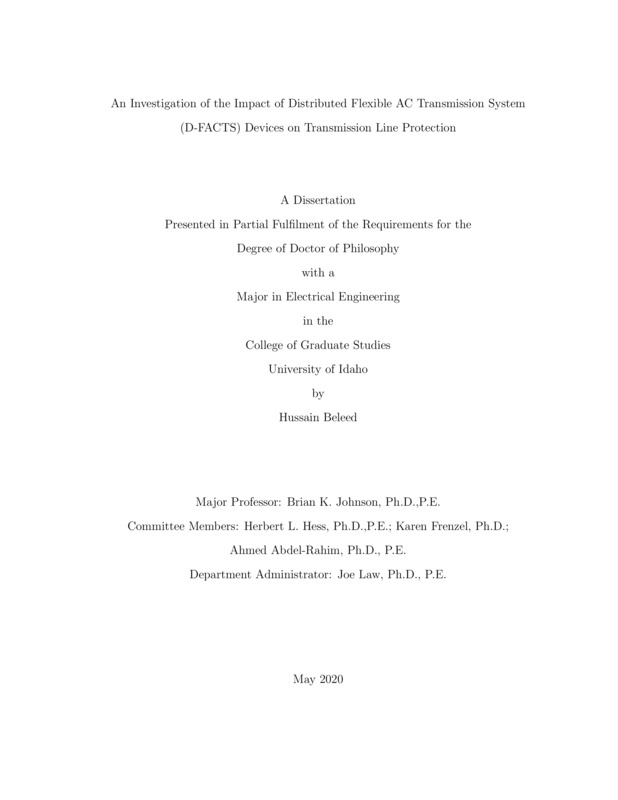An Investigation of the Impact of Distributed Flexible AC Transmission System (D-FACTS) Devices on Transmission Line Protection
Beleed, Hussain. (2020-05). An Investigation of the Impact of Distributed Flexible AC Transmission System (D-FACTS) Devices on Transmission Line Protection. Theses and Dissertations Collection, University of Idaho Library Digital Collections. https://www.lib.uidaho.edu/digital/etd/items/beleed_idaho_0089e_11796.html
- Title:
- An Investigation of the Impact of Distributed Flexible AC Transmission System (D-FACTS) Devices on Transmission Line Protection
- Author:
- Beleed, Hussain
- Date:
- 2020-05
- Program:
- Electrical and Computer Engineering
- Subject Category:
- Electrical engineering
- Abstract:
-
This thesis explores the effects of inductive Distributed Flexible AC Transmission System (D-FACTS) device implementations on the performance of different transmission line protection schemes. The reliability and sensitivity of the trip decision of the protection elements is crucial for delivering safe and reliable power to customers. Furthermore, accurate fault location information can help significantly reduce outage duration, operating costs, and the number of consumer complaints. Inductive D-FACTS devices offer a distributed solution for managing and relieving the congestion in transmission lines. However, their interaction with protection and fault location elements may potentially cause unnecessary tripping, relay mis-operation, or misleading fault location information. The operation of these devices may also lead to unpredictable changes in transmission line impedance and fault current limitation due to their dynamic behavior before and during the disturbances. This work studies these negative aspects of D-FACTS devices and proposes solutions and alternatives to mitigate their impact.
An inductive D-FACTS model was developed in the ATP version of the Electromagnetic Transients Program (EMTP) and then the steady-state performance of these devices was validated against the existing D-FACTS model in PowerWorld using the IEEE 12 bus test system. Once the model was validated, a more practical system with D-FACTS implementation is simulated using ATP. Lastly, the generated fault event files are played back into commercial relays and a protective relay software model for evaluation.
This work examines the influence of two different implementations of inductive D-FACTS on the most common protection elements and schemes under different fault scenarios. The types of D-FACTS devices implementations studied were: dispersed (distributing the D-FACTS along the length of the line) and compressed (distributing them at specific distances on the line). Additionally, the impact of placing D-FACTS devices on adjacent lines was studied. Protection schemes studied in this thesis include distance elements (mho or quadrilateral elements), communication aided distance schemes (permissive overreaching transfer trip [POTT]), and fault location schemes. Furthermore, the influence of fault resistance and mutual coupling between parallel lines on relay response is studied in the presence of D-FACTS devices.
Dispersed or compressed D-FACTS implementation can cause underreaching of distance elements. This may lead to a delay in the tripping time or in fact, a failure to trip in a POTT scheme. The simulation results show that using dispersed D-FACTS implementation can reduce the error compared to the compressed implementation, and increase the ability of performing correction for these devices under some operating conditions.
This work also examined the effect of D-FACTS devices on distance elements' performance in presence of a fault resistance and mutual coupling between the parallel lines. The results illustrated how the direction of the power flow influences the fault resistance coverage of distance elements in the presence of D-FACTS devices. The D-FACTS may help to reduce the distance elements' underreach for forward faults and increase the underreach behavior for the reverse fault. The results show that mutual coupling influence on distance elements would be not impacted by addition of the D-FACTS devices.
Lastly, we investigated how implementing inductive D-FACTS devices on the adjacent line affects the dynamic behavior of mho distance elements and the calculated effective impedance tilt of quadrilateral distance elements' response. Inserting the D-FACTS behind the relay can help expand the mho circles for forward faults and contract them for reverse faults. As a result, fault resistance coverage can be improved. On the other hand, this may cause underreaching or overreaching of the quadrilateral distance elements' response when a fault resistance is present in a ground fault.
To deal with the challenges in the implementation of D-FACTS devices and minimize their influence on transmission line protection system performance, this thesis proposes mitigation for creating reliable protection and fault location schemes. The work concludes by offering recommendations for D-FACTS device implementation and protective relays' settings.
- Description:
- doctoral, Ph.D., Electrical and Computer Engineering -- University of Idaho - College of Graduate Studies, 2020-05
- Major Professor:
- Johnson, Brian K
- Committee:
- Hess, Herbert L; Abdel-Rahim, Ahmed; Frenzel, Karen
- Defense Date:
- 2020-05
- Identifier:
- Beleed_idaho_0089E_11796
- Type:
- Text
- Format Original:
- Format:
- application/pdf
- Rights:
- In Copyright - Educational Use Permitted. For more information, please contact University of Idaho Library Special Collections and Archives Department at libspec@uidaho.edu.
- Standardized Rights:
- http://rightsstatements.org/vocab/InC-EDU/1.0/

